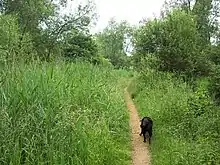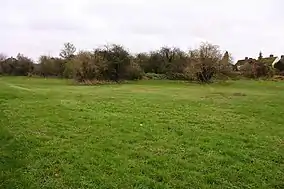List of local nature reserves in Oxfordshire
Local nature reserves (LNRs) in England are designated by local authorities under Section 21 of the National Parks and Access to the Countryside Act 1949.[1] LNRs are sites which have a special local interest either biologically or geologically. Local authorities have a duty to care for them, and must control the sites by owning or leasing them, or by having an agreement with the owners. The local authorities can apply local byelaws to manage and protect LNRs.[2]
As of February 2020, there are fifteen LNRs in Oxfordshire,[3] a county in South East England with an area of 2,605 square kilometres and a population of 648,700.
Key
Other designations and wildlife trust management
Sites
| Site | Photograph | Area[lower-alpha 1] | District | Other | Map[lower-alpha 2] and details[lower-alpha 1] | Description | |
|---|---|---|---|---|---|---|---|
| Abbey Fishponds | 5.6 hectares (14 acres) |
Abingdon 51.678°N 1.262°W SU 511 980 |
Vale of White Horse | Map and Details | |||
| Adderbury Lakes | _(geograph_2935627).jpg.webp) |
1.8 hectares (4.4 acres) |
Adderbury 52.016°N 1.306°W SP 477 355 |
Cherwell | Map and Details | The lakes were created by Capability Brown in about 1768 as part of the landscaping of the grounds of Adderbury House.[4] The reserve also includes woodland around the lakes and there is diverse wildlife.[5] | |
| Bure Park | %252C_Bicester_-_geograph.org.uk_-_1416179.jpg.webp) |
8.4 hectares (21 acres) |
Bicester 51.909°N 1.161°W SP 578 237 |
Cherwell | Map and Details | The River Bure runs through the park and supplies water to a pond which has great crested newts. Habitats include grassland, scrub, broadleaved woodland and hedges.[6] | |
| Crecy Hill | .jpg.webp) |
0.8 hectares (2.0 acres) |
Tackley 51.887°N 1.230°W SP 483 212 |
West Oxfordshire | Map and Details | This steeply sloping limestone bank has a calcareous grassland habitat. More than 100 wild flower species and 15 grasses have been recorded. There are also more than 100 insect species, including 20 butterflies such as the small blue.[7] | |
| Cuttle Brook | .jpg.webp) |
13.0 hectares (32 acres) |
Thame 51.745°N 0.986°W SP 701 056 |
South Oxfordshire | Map and Details | There are seven entrances to this site close to Thame town centre. It has diverse habitats, including the brook and its banks, scrub, woodland, meadows, reed beds, hedges and sedge beds.[8] | |
| Ewelme Watercress Beds |  |
2.6 hectares (6.4 acres) |
Wallingford 51.621°N 1.078°W SU 639 917 |
South Oxfordshire | Map and Details | A stream runs through these former watercress beds, fed by a spring.[9] Wildlife includes water voles, together with diverse invertebrates and plants.[10] | |
| Kirtlington Quarry |  |
7.4 hectares (18 acres) |
Kirtlington 51.875°N 1.285°W SP 493 198 |
Cherwell | GCR,[11][12] SSSI[13] | Map and Details | Britain has the only five Middle Jurassic mammal sites in the world, and this disused quarry has yielded the richest and most diverse assemblage. It dates to the Upper Bathonian, around 150 million years ago. There are nine therian and prototherians species, together with a tritylodontid. There are also fossils of theropod dinosaurs, crocodilians, pterosaurs, fishes and many shark teeth.[14] |
| Lye Valley |  |
4.5 hectares (11 acres) |
Headington 51.748°N 1.209°W SP 547 058 |
Oxford | SSSI[15] | Map and Details | This a calcareous valley fen, which is a nationally rare and threatened habitat. It is drained by the Lye Brook. There is a variety of moss species, such as Drepanocladus revolvens and Campylium stellatum. Invertebrates include the nationally rare soldier fly, Vanoyia tenuicornis and the uncommon spiders, Xysticus ulmi and Anistea elegans.[16] |
| Magdalen Quarry | 0.4 hectares (0.99 acres) |
Oxford 51.760°N 1.203°W SP 551 071 |
Oxford | GCR,[17] SSSI[18] | Map and Details | ||
| Mowbray Fields | .jpg.webp) |
2.2 hectares (5.4 acres) |
Didcot 51.595°N 1.246°W SU 523 887 |
South Oxfordshire | Map and Details | This nature reserve next to the Hagbourne Brook has a wildflower meadow, a disused railway embankment, a pond and wetland. There are many common spotted and southern marsh orchids, and more than 200 species of invertebrates have been recorded.[19] | |
| Rock Edge |  |
1.8 hectares (4.4 acres) |
Oxford 51.754°N 1.206°W SP 549 064 |
Oxford | GCR,[20] SSSI[21] | Map and Details | This site exposes limestone rich in coral called Coral rag, laid down when the area was under a warm, shallow sea, similar to the Bahama Banks today. It is rich in fossils derived from the coral reefs. It dates to the Upper Jurassic, around 145 million years ago.[22] |
| Saltway | .jpg.webp) |
2.0 hectares (4.9 acres) |
Chipping Norton 51.873°N 1.444°W SP 384 195 |
West Oxfordshire | SSSI[23] | Map and Details | This is a stretch of an ancient track together with its species-rich grass verges and hedges. It has been designated an SSSI because it has the largest known British colony of the very rare downy woundwort, with more than 100 seedlings and 60 flowering stems. The plant is associated with hedges along Roman roads and ancient tracks on calcareous soils, and Salt Way may date to the Roman period.[24] |
| The Slade | 2.1 hectares (5.2 acres) |
Bloxham 52.015°N 1.388°W SP 421 354 |
Cherwell | Map and Details | |||
| Tuckmill Meadows | 5.7 hectares (14 acres) |
Shrivenham 51.607°N 1.656°W SU 239 899 |
Vale of White Horse | SSSI[25] | Map and Details | ||
| Watlington Chalk Pit | .jpg.webp) |
1.6 hectares (4.0 acres) |
Watlington 51.640°N 0.991°W SU 699 940 |
South Oxfordshire | SSSI[26] | Map and Details | This site has floristically rich chalk grassland and scrub. There are many lichens, mosses and liverworts, and twenty species of butterfly have been recorded. Wintering birds include fieldfares, redwings, yellowhammer and linnets.[27] |
See also
Notes
- The area and grid reference are on the "Details" page on each site in the Natural England database of local nature reserves.[3]
- The maps are on the Natural England database of local nature reserves.
References
- "Local Nature Reserve". Peak District National Park Authority. 15 February 2017. Retrieved 3 February 2020.
- "Local nature reserves: setting up and management". Department for Environment, Food & Rural Affairs and Natural England. 2 October 2014. Archived from the original on 4 July 2015. Retrieved 29 July 2015.
- "Designated Sites View: Oxfordshire". Local Nature Reserves. Natural England. Retrieved 15 February 2020.
- "Adderbury House". Parks & Gardens. Retrieved 8 April 2020.
- "Adderbury Lakes". Local Nature Reserves. Natural England. Retrieved 8 April 2020.
- "Bure Park". Local Nature Reserves. Natural England. Retrieved 30 March 2020.
- "Crecy Hill". Local Nature Reserves. Natural England. Retrieved 16 March 2020.
- "Cuttle Brook". Local Nature Reserves. Natural England. Retrieved 8 April 2020.
- "Ewelme Watercress Beds & Local Nature Reserve". The Chiltern Society. Retrieved 30 March 2020.
- "Ewelme Watercress Beds". Local Nature Reserves. Natural England. Retrieved 30 March 2020.
- "Kirtlington (Jurassic - Cretaceous Reptilia)". Geological Conservation Review. Joint Nature Conservation Committee. Retrieved 26 February 2020.
- "Kirtlington Old Cement Works Quarry (Mesozoic - Tertiary Fish/Amphibia)". Geological Conservation Review. Joint Nature Conservation Committee. Retrieved 26 February 2020.
- "Designated Sites View: Kirtlington Quarry". Sites of Special Scientific Interest. Natural England. Retrieved 26 February 2020.
- "Kirtlington Quarry citation" (PDF). Sites of Special Scientific Interest. Natural England. Retrieved 27 March 2020.
- "Designated Sites View: Lye Valley". Sites of Special Scientific Interest. Natural England. Retrieved 26 February 2020.
- "Lye Valley citation" (PDF). Sites of Special Scientific Interest. Natural England. Retrieved 27 March 2020.
- "Magdalen Pit (Oxfordian)". Geological Conservation Review. Joint Nature Conservation Committee. Retrieved 26 February 2020.
- "Designated Sites View: Magdalen Quarry". Sites of Special Scientific Interest. Natural England. Retrieved 26 February 2020.
- "Mowbray Fields". Local Nature Reserves. Natural England. Retrieved 8 April 2020.
- "Cross Roads Quarry (Oxfordian)". Geological Conservation Review. Joint Nature Conservation Committee. Retrieved 26 February 2020.
- "Designated Sites View: Rock Edge". Sites of Special Scientific Interest. Natural England. Retrieved 26 February 2020.
- "Rock Edge citation" (PDF). Sites of Special Scientific Interest. Natural England. Retrieved 28 March 2020.
- "Designated Sites View: Salt Way, Ditchley". Sites of Special Scientific Interest. Natural England. Retrieved 26 February 2020.
- "Salt Way, Ditchley citation" (PDF). Sites of Special Scientific Interest. Natural England. Retrieved 7 April 2020.
- "Designated Sites View: Tuckmill Meadows". Sites of Special Scientific Interest. Natural England. Retrieved 26 February 2020.
- "Designated Sites View: Watlington and Pyrton Hills". Sites of Special Scientific Interest. Natural England. Retrieved 26 February 2020.
- "Watlington Chalk Pit". Local Nature Reserves. Natural England. Retrieved 30 March 2020.
This article is issued from Wikipedia. The text is licensed under Creative Commons - Attribution - Sharealike. Additional terms may apply for the media files.